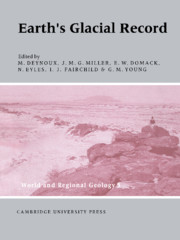Book contents
- Frontmatter
- Contents
- List of contributors
- Preface
- Acknowledgements
- 1 Geodynamic controls on glaciation in Earth history
- 2 Glacial-marine facies in a continental rift environment: Neoproterozoic rocks of the western United States Cordillera
- 3 The Neoproterozoic Konnarock Formation, southwestern Virginia, USA: glaciolacustrine facies in a continental rift
- 4 Glaciogenic deposits of the Permo-Carboniferous Dwyka Group in the eastern region of the Karoo Basin, South Africa
- 5 Itararé Group: Gondwanan Carboniferous-Permian of the Paraná Basin, Brazil
- 6 The interpretation of massive rain-out and debris-flow diamictites from the glacial marine environment
- 7 Neoproterozoic tillite and tilloid in the Aksu area, Tarim Basin, Uygur Xinjiang Autonomous Region, Northwest China
- 8 Lithology, sedimentology and genesis of the Zhengmuguan Formation of Ningxia, China
- 9 Architectural styles of glacially influenced marine deposits on tectonically active and passive margins
- 10 Marine to non-marine sequence architecture of an intracratonic glacially related basin. Late Proterozoic of the West African platform in western Mali
- 11 The enigmatic Late Proterozoic glacial climate: an Australian perspective
- 12 Isotopic signatures of carbonates associated with Sturtian (Neoproterozoic) glacial facies, central Flinders Ranges, South Australia
- 13 Reactive carbonate in glacial systems: a preliminary synthesis of its creation, dissolution and reincarnation
- 14 A Permian argillaceous syn- to post-glacial foreland sequence in the Karoo Basin, South Africa
- 15 A palaeoenvironmental study of black mudrock in the glacigenic Dwyka Group from the Boshof-Hertzogville region, northern part of the Karoo Basin, South Africa
- 16 Late Paleozoic post-glacial inland sea filled by fine-grained turbidites: Mackellar Formation, Central Transantarctic Mountains
- 17 Ice scouring structures in Late Paleozoic rhythmites, Paraná Basin, Brazil
- 18 Soft-sediment striated surfaces and massive diamicton facies produced by floating ice
- 19 Environmental evolution during the early phase of Late Proterozoic glaciation, Hunan, China
8 - Lithology, sedimentology and genesis of the Zhengmuguan Formation of Ningxia, China
Published online by Cambridge University Press: 06 July 2010
- Frontmatter
- Contents
- List of contributors
- Preface
- Acknowledgements
- 1 Geodynamic controls on glaciation in Earth history
- 2 Glacial-marine facies in a continental rift environment: Neoproterozoic rocks of the western United States Cordillera
- 3 The Neoproterozoic Konnarock Formation, southwestern Virginia, USA: glaciolacustrine facies in a continental rift
- 4 Glaciogenic deposits of the Permo-Carboniferous Dwyka Group in the eastern region of the Karoo Basin, South Africa
- 5 Itararé Group: Gondwanan Carboniferous-Permian of the Paraná Basin, Brazil
- 6 The interpretation of massive rain-out and debris-flow diamictites from the glacial marine environment
- 7 Neoproterozoic tillite and tilloid in the Aksu area, Tarim Basin, Uygur Xinjiang Autonomous Region, Northwest China
- 8 Lithology, sedimentology and genesis of the Zhengmuguan Formation of Ningxia, China
- 9 Architectural styles of glacially influenced marine deposits on tectonically active and passive margins
- 10 Marine to non-marine sequence architecture of an intracratonic glacially related basin. Late Proterozoic of the West African platform in western Mali
- 11 The enigmatic Late Proterozoic glacial climate: an Australian perspective
- 12 Isotopic signatures of carbonates associated with Sturtian (Neoproterozoic) glacial facies, central Flinders Ranges, South Australia
- 13 Reactive carbonate in glacial systems: a preliminary synthesis of its creation, dissolution and reincarnation
- 14 A Permian argillaceous syn- to post-glacial foreland sequence in the Karoo Basin, South Africa
- 15 A palaeoenvironmental study of black mudrock in the glacigenic Dwyka Group from the Boshof-Hertzogville region, northern part of the Karoo Basin, South Africa
- 16 Late Paleozoic post-glacial inland sea filled by fine-grained turbidites: Mackellar Formation, Central Transantarctic Mountains
- 17 Ice scouring structures in Late Paleozoic rhythmites, Paraná Basin, Brazil
- 18 Soft-sediment striated surfaces and massive diamicton facies produced by floating ice
- 19 Environmental evolution during the early phase of Late Proterozoic glaciation, Hunan, China
Summary
Abstract
In the central segment of the Helan Mountain of Ningxia three Proterozoic sedimentary units are underlain by the Huangqikou Granite (K/Ar ages: 1440–1839 Ma). The Proterozoic sequences include, in ascending order, the Huangqikou Group composed of shallow marine clastic deposits, the Wangquankou Group consisting of carbonates and yielding a K/Ar age of 1289 Ma on glauconite from its base. The youngest formation is the Zhengmuguan Formation, which rests unconformably on the underlying beds. Still higher, the Cambrian Suyukou Formation, which contains trilobites, disconformably overlies the terminal Proterozoic to Early Cambrian Zhengmuguan Formation.
The Zhengmuguan Formation can be subdivided into two members. The lower member is composed of diamictite containing carbonate clasts, and the upper one is made up of stratified fine clastic deposits and argillites. The diamictite is mainly subglacial in origin. Intercalations of laminated rocks with dropstones within the diamictite member suggest ice sheet fluctuation and repeated climatic changes. The upper fine clastic and argillaceous rocks with abundant trace fossils were deposited in a relatively deep and stable periglacial basin.
REE data from shales of the upper Zhengmuguan Formation illustrate that they have a high REE abundance (208.7 ppm), a high (La/Yb)N ratio and an obvious negative Eu anomaly. Their REE patterns are quite similar to those of post-Archean shales in western Europe, America and Australia.
Introduction
The Zhengmuguan Formation crops out in the middle segment of the Helan Mountain within a limited area of about 300 km2 (Fig. 8.1). This sequence is named after the type section located in Zhengmuguan (Compiling Group of Stratigraphical Timescale of Ningxia Hui Autonomous Region, 1980).
- Type
- Chapter
- Information
- Earth's Glacial Record , pp. 101 - 108Publisher: Cambridge University PressPrint publication year: 1994



